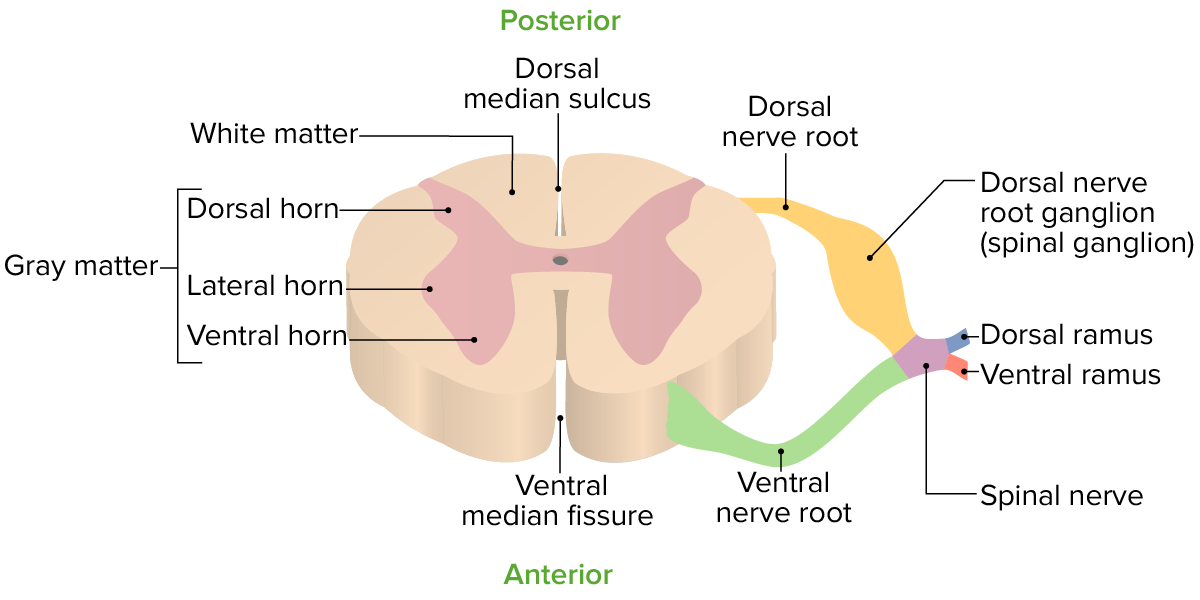Playlist
Show Playlist
Hide Playlist
Case: 22-year-old Woman with Back Pain and Autonomic Symptoms
-
Slides Diseases of the Spinal Cord.pdf
-
Download Lecture Overview
00:00 Next, let's talk about myelopathy and the difference between a conus medullaris and cauda equina syndrome. This is critically important for evaluating patients and for addressing test questions and multiple choice questions in patients who may be presenting with myelopathy. And let's start with a case. This is a 22-year-old who presents with low back pain, saddle anesthesia, and bowel and bladder retention. 00:27 These findings are already pointing us to possible spinal cord pathology with the prominent bowel/bladder dysfunction and saddle anesthesia. As we interrogate some of these symptoms a little bit more, we find that the back pain radiates to the lower extremities bilaterally with associated tingling and numbness. There are radiculopathy symptoms going down the legs. The pain radiates bilaterally into her lower extremities. 00:51 In terms of the constipation and retention symptoms, they started 3 weeks ago and is progressively worsening. On retrospect, the patient reports low back pain with radiation into her legs bilaterally for approximately 1 year, so a longer history of back pain. Prior to that, approximately 3 years ago she had mentioned once or twice this similar radiation of pain down her legs. Examination of the left lower extremity shows asymmetric weakness with dorsiflexion, 5/5 full strength with knee flexion and knee extension, and the right leg is full strength 5/5 throughout. On sensory exam, sensation is intact to touch and pain bilaterally in the upper extremities, decreased to light touch over the perianal region and in the posterior thighs bilaterally. There is asymmetric hypo and even areflexia in the legs bilaterally and rectal tone is absent. 01:42 These findings are clearly concerning for a spinal cord disorder and this asymmetric presentation suggest that this may actually fall outside of the spinal cord and in that region of the cauda equina where there is some problem picking off different nerves that is descending to the legs and to the autonomic supply to bowel and bladder function. And here we see some of the key features of this case. Decreased light touch in the perianal region going along with that saddle anesthesia which is highly concerning for a lower cord problem either conus medullaris or cauda equina syndrome. 02:17 We also see that this patient has asymmetric hyper and areflexia and rectal tone is absent which also points us to a pathology in that area. So what's the most likely diagnosis? Transverse myelitis, cervical spondylosis, lumbar radiculopathy, or a cauda equina tumor. Well, transverse myelitis is unlikely to be the underlying etiology in this case. A transverse myelitis is a central nervous system disorder. These patients present with prominent upper motor neuron signs. There can be some asymmetry but often the increase in reflexes or upper motor neuron signs are present bilaterally which is not the case for this patient. This also doesn't sound like cervical spondylosis. 03:00 Cervical spondylosis is also a central nervous system disorder, a disorder affecting the central nervous system nerves. Patients present with upper motor neuron signs, symptoms beginning in the legs and then developing and progressing into the hands with external compression which we don't see in this case. Lumbar radiculopathy doesn't sound like the right diagnosis for this patient either. The patient presents with symptoms of diffuse lumbosacral dysfunction, not a single nerve that's involved but multiple nerves throughout the lumbosacral plexus which is inconsistent with what we'd expect for a lumbar radiculopathy. And ultimately, this syndrome was consistent with cauda equina syndrome and this patient was diagnosed with a cauda equina tumor. Patients present with cauda equina syndrome and have diffuse lower motor neuron symptoms of the spinal nerve roots which you are seeing in both the strength, sensory, and reflex exam for this patient. And here we have the MRI for this patient. We're looking at a lumbar MRI. These are the T1 post contrast images and we see a large homogenously enhancing mass in the lumbar spine on the sagittal and also on the axial. On the axial, it's taking up nearly the entirety of the thecal sac. 04:14 This was compressing slowly progressing those cauda equina nerve roots resulting in cauda equina syndrome and required surgical intervention. And this is one example of the types of pathology that we can see in the cauda equina.
About the Lecture
The lecture Case: 22-year-old Woman with Back Pain and Autonomic Symptoms by Roy Strowd, MD is from the course Diseases of the Spinal Cord.
Included Quiz Questions
Which of the following symptoms suggests a pathology involving the cauda equina?
- Numbness in the perineum
- Leg weakness
- Nonradiating back pain
- Skin itching
- Difficulty with balance
Which of the following is a sign of cauda equina syndrome?
- Rectal atonia
- Lower extremity edema
- Hyperreflexia
- Weakness in the upper extremities
- Atrophic skin ulcers on the lower back
Customer reviews
5,0 of 5 stars
| 5 Stars |
|
5 |
| 4 Stars |
|
0 |
| 3 Stars |
|
0 |
| 2 Stars |
|
0 |
| 1 Star |
|
0 |




